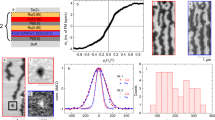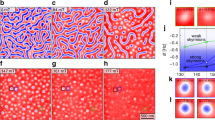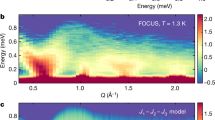Abstract
Room-temperature skyrmions in ferromagnetic films and multilayers show promise for encoding information bits in new computing technologies. Despite recent progress, ferromagnetic order generates dipolar fields that prevent ultrasmall skyrmion sizes, and allows a transverse deflection of moving skyrmions that hinders their efficient manipulation. Antiferromagnetic skyrmions shall lift these limitations. Here we demonstrate that room-temperature antiferromagnetic skyrmions can be stabilized in synthetic antiferromagnets (SAFs), in which perpendicular magnetic anisotropy, antiferromagnetic coupling and chiral order can be adjusted concurrently. Utilizing interlayer electronic coupling to an adjacent bias layer, we demonstrate that spin-spiral states obtained in a SAF with vanishing perpendicular magnetic anisotropy can be turned into isolated antiferromagnetic skyrmions. We also provide model-based estimates of skyrmion size and stability, showing that room-temperature antiferromagnetic skyrmions below 10 nm in radius can be anticipated in further optimized SAFs. Antiferromagnetic skyrmions in SAFs may thus solve major issues associated with ferromagnetic skyrmions for low-power spintronic devices.
This is a preview of subscription content, access via your institution
Access options
Access Nature and 54 other Nature Portfolio journals
Get Nature+, our best-value online-access subscription
$29.99 / 30 days
cancel any time
Subscribe to this journal
Receive 12 print issues and online access
$259.00 per year
only $21.58 per issue
Buy this article
- Purchase on Springer Link
- Instant access to full article PDF
Prices may be subject to local taxes which are calculated during checkout





Similar content being viewed by others
Data availability
All relevant data presented in the manuscript and in the Supplementary Information supporting the findings of this study are available from the corresponding authors upon request.
References
Bogdanov, A. N. & Rößler, U. K. Chiral symmetry breaking in magnetic thin films and multilayers. Phys. Rev. Lett. 87, 037203 (2001).
Rößler, U. K., Bogdanov, A. N. & Pfleiderer, C. Spontaneous skyrmion ground states in magnetic metals. Nature 442, 797–801 (2006).
Dzyaloshinsky, I. A thermodynamic theory of weak ferromagnetism of antiferromagnetics. J. Phys. Chem. Solids 4, 241–255 (1958).
Moriya, T. Anisotropic superexchange interaction and weak ferromagnetism. Phys. Rev. 120, 91–98 (1960).
Bode, M. et al. Chiral magnetic order at surfaces driven by inversion asymmetry. Nature 447, 190–193 (2007).
Heide, M., Bihlmayer, G. & Blügel, S. Dzyaloshinskii–Moriya interaction accounting for the orientation of magnetic domains in ultrathin films: Fe/W(110). Phys. Rev. B 78, 140403 (2008).
Kiselev, N. S., Bogdanov, A. N., Schäfer, R. & Rößler, U. K. Chiral skyrmions in thin magnetic films: new objects for magnetic storage technologies? J. Phys. D 44, 392001 (2011).
Fert, A., Reyren, N. & Cros, V. Magnetic skyrmions: advances in physics and potential applications. Nat. Rev. Mat. 2, 17031 (2017).
Romming, N. et al. Writing and deleting single magnetic skyrmions. Science 341, 636–639 (2013).
Woo, S. et al. Observation of room-temperature magnetic skyrmions and their current-driven dynamics in ultrathin metallic ferromagnets. Nat. Mater. 15, 501–506 (2016).
Legrand, W. et al. Room-temperature current-induced generation and motion of sub-100 nm skyrmions. Nano Lett. 17, 2703–2712 (2017).
Büttner, F. et al. Field-free deterministic ultrafast creation of magnetic skyrmions by spin–orbit torques. Nat. Nanotechnol. 12, 1040–1044 (2017).
Woo, S. et al. Deterministic creation and deletion of a single magnetic skyrmion observed by direct time-resolved X-ray microscopy. Nat. Electron. 1, 288–296 (2018).
Hrabec, A. et al. Current-induced skyrmion generation and dynamics in symmetric bilayers. Nat. Commun. 8, 15765 (2017).
Maccariello, D. et al. Electrical detection of single magnetic skyrmions in metallic multilayers at room temperature. Nat. Nanotechnol. 13, 233–237 (2018).
Zeissler, K. et al. Discrete hall resistivity contribution from néel skyrmions in multilayer nanodiscs. Nature Nanotechnol. 13, 1161–1166 (2018).
Büttner, F., Lemesh, I. & Beach, G. S. D. Theory of isolated magnetic skyrmions: from fundamentals to room temperature applications. Sci. Rep. 8, 4464 (2018).
Moreau-Luchaire, C. et al. Additive interfacial chiral interaction in multilayers for stabilization of small individual skyrmions at room temperature. Nat. Nanotechnol. 11, 444–448 (2016).
Boulle, O. et al. Room-temperature chiral magnetic skyrmions in ultrathin magnetic nanostructures. Nat. Nanotechnol. 11, 449–454 (2016).
Barker, J. & Tretiakov, O. A. Static and dynamical properties of antiferromagnetic skyrmions in the presence of applied current and temperature. Phys. Rev. Lett. 116, 147203 (2016).
Nagaosa, N. & Tokura, Y. Topological properties and dynamics of magnetic skyrmions. Nat. Nanotechnol. 8, 899–911 (2013).
Jiang, W. et al. Direct observation of the skyrmion Hall effect. Nat. Phys. 13, 162–169 (2017).
Litzius, K. et al. Skyrmion Hall effect revealed by direct time-resolved X-ray microscopy. Nat. Phys. 13, 170–175 (2017).
Zhang, X., Zhou, Y. & Ezawa, M. Magnetic bilayer-skyrmions without skyrmion Hall effect. Nat. Commun. 7, 10293 (2016).
Sampaio, J., Cros, V., Rohart, S., Thiaville, A. & Fert, A. Nucleation, stability and current-induced motion of isolated magnetic skyrmions in nanostructures. Nat. Nanotechnol. 8, 839–844 (2013).
Woo, S. et al. Current-driven dynamics and inhibition of the skyrmion Hall effect of ferrimagnetic skyrmions in GdFeCo films. Nat. Commun. 9, 959 (2018).
Caretta, L. et al. Fast current-driven domain walls and small skyrmions in a compensated ferrimagnet. Nat. Nanotechnol. 13, 1154–1160 (2018).
Parkin, S. S. P., Bhadra, R. & Roche, K. P. Oscillatory magnetic exchange coupling through thin copper layers. Phys. Rev. Lett. 66, 2152–2155 (1991).
Zhang, X., Zhou, Y. & Ezawa, M. Antiferromagnetic skyrmion: stability, creation and manipulation. Sci. Rep. 6, 24795 (2016).
Hellwig, O., Kirk, T. L., Kortright, J. B., Berger, A. & Fullerton, E. E. A new phase diagram for layered antiferromagnetic films. Nat. Mater. 2, 112–116 (2003).
Hervé, M. et al. Stabilizing spin spirals and isolated skyrmions at low magnetic field exploiting vanishing magnetic anisotropy. Nat. Commun. 9, 1015 (2018).
Hrabec, A. et al. Measuring and tailoring the Dzyaloshinskii–Moriya interaction in perpendicularly magnetized thin films. Phys. Rev. B 90, 020402 (2014).
Belmeguenai, M. et al. Interface Dzyaloshinskii–Moriya interaction in the interlayer antiferromagnetic-exchange coupled Pt/CoFeB/Ru/CoFeB systems. Phys. Rev. B 96, 144402 (2017).
Bloemen, P. J. H., van Kesteren, H. W., Swagten, H. J. M. & de Jonge, W. J. M. Oscillatory interlayer exchange coupling in Co/Ru multilayers and bilayers. Phys. Rev. B 50, 13505–13514 (1994).
Lavrijsen, R. et al. Magnetic ratchet for three-dimensional spintronic memory and logic. Nature 493, 647–650 (2013).
Bandiera, S., Sousa, R. C., Auffret, S., Rodmacq, B. & Dieny, B. Enhancement of perpendicular magnetic anisotropy thanks to Pt insertions in synthetic antiferromagnets. Appl. Phys. Lett. 101, 072410 (2012).
Lavrijsen, R. et al. Tuning the interlayer exchange coupling between single perpendicularly magnetized CoFeB layers. Appl. Phys. Lett. 100, 052411 (2012).
Yakushiji, K. et al. Ultrathin Co/Pt and Co/Pd superlattice films for MgO-based perpendicular magnetic tunnel junctions. Appl. Phys. Lett. 97, 232508 (2010).
Moritz, J., Garcia, F., Toussaint, J. C., Dieny, B. & Nozières, J. P. Orange peel coupling in multilayers with perpendicular magnetic anisotropy: application to (Co/Pt)-based exchange-biased spin-valves. Europhys. Lett. 65, 123–129 (2004).
Hellwig, O., Berger, A. & Fullerton, E. E. Domain walls in antiferromagnetically coupled multilayer films. Phys. Rev. Lett. 91, 197203 (2003).
Legrand, W. et al. Modeling the shape of axisymmetric skyrmions in magnetic multilayers. Phys. Rev. Appl. 10, 064042 (2018).
Vansteenkiste, A. et al. The design and verification of MuMax3. AIP Adv. 4, 107133 (2014).
Rohart, S., Miltat, J. & Thiaville, A. Path to collapse for an isolated néel skyrmion. Phys. Rev. B 93, 214412 (2016).
Legrand, W. et al. Hybrid chiral domain walls and skyrmions in magnetic multilayers. Sci. Adv. 4, eaat0415 (2018).
Hanneken, C. et al. Electrical detection of magnetic skyrmions by tunnelling non-collinear magnetoresistance. Nat. Nanotechnol. 10, 1039–1042 (2015).
Crum, D. M. et al. Perpendicular reading of single confined magnetic skyrmions. Nat. Commun. 6, 8541 (2015).
Bessarab, P. F. et al. Lifetime of racetrack skyrmions. Sci. Rep. 8, 3433 (2018).
Bessarab, P. F. et al. Stability and lifetime of antiferromagnetic skyrmions. Phys. Rev. B 99, 140411 (2019).
Wild, J. et al. Entropy-limited topological protection of skyrmions. Sci. Adv. 3, e1701704 (2017).
Belavin, A. & Polyakov, A. Metastable states of two-dimensional isotropic ferromagnets. JETP Lett. 22, 245–248 (1975).
Acknowledgements
The authors thank Y. Sassi for his participation to additional experiments included in the Supplementary Information and W. Akhtar, A. Finco, S. Chouaieb and V. Jacques for discussions about the magnetic imaging of SAFs. Financial support from the Agence Nationale de la Recherche, France, under grant agreement no. ANR-17-CE24-0025 (TOPSKY), the Horizon2020 Framework Programme of the European Commission under FET-Proactive Grant agreement no. 824123 (SKYTOP) and FET-Open grant agreement no. 665095 (MAGicSky), and the DARPA TEE programme through grant MIPR no. HR0011831554 is acknowledged.
Author information
Authors and Affiliations
Contributions
W.L., N.R., V.C. and A.F. conceived the project. W.L. deposited the multilayered films, with the help of S.C. and F.A. W.L. and F.A. performed the magnetic characterization of the SAFs and optimization of the magnetic properties. W.L., D.M. and F.A. performed the MFM experiments, with the help of K.B. and A.V. W.L. performed the micromagnetic simulations. W.L., N.R. and V.C. prepared the manuscript, and all authors discussed and contributed to the final manuscript.
Corresponding authors
Ethics declarations
Competing interests
The authors declare no competing interests.
Additional information
Publisher’s note: Springer Nature remains neutral with regard to jurisdictional claims in published maps and institutional affiliations.
Supplementary information
Supplementary Information
Supplementary Notes 1–12, Supplementary Figs. 1–26, Supplementary Tables 1–7 and Supplementary refs. 1–11.
Rights and permissions
About this article
Cite this article
Legrand, W., Maccariello, D., Ajejas, F. et al. Room-temperature stabilization of antiferromagnetic skyrmions in synthetic antiferromagnets. Nat. Mater. 19, 34–42 (2020). https://doi.org/10.1038/s41563-019-0468-3
Received:
Accepted:
Published:
Issue Date:
DOI: https://doi.org/10.1038/s41563-019-0468-3
This article is cited by
-
Distinct skyrmion phases at room temperature in two-dimensional ferromagnet Fe3GaTe2
Nature Communications (2024)
-
Spontaneous Small Biskyrmions in a Centrosymmetric Rare-Earth Kagome Ferrimagnet
NPG Asia Materials (2024)
-
Homochiral antiferromagnetic merons, antimerons and bimerons realized in synthetic antiferromagnets
Nature Communications (2024)
-
Spatially reconfigurable antiferromagnetic states in topologically rich free-standing nanomembranes
Nature Materials (2024)
-
Topological Kerr effects in two-dimensional magnets with broken inversion symmetry
Nature Physics (2024)



